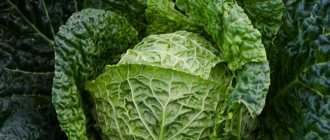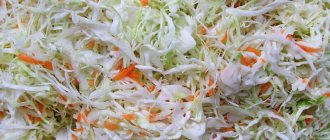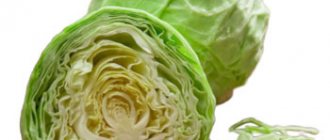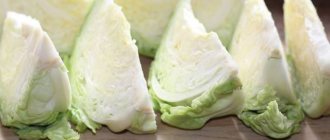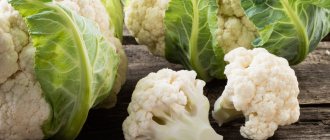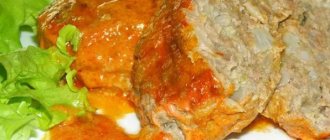Many housewives do not like to cook cabbage rolls precisely because of the need to cook cabbage. To soften it, it is boiled for a long time in a large saucepan, scalded, pulled out, and waited for it to cool. The process is not fast and not very pleasant. But there is a much better way to soften cabbage leaves for cabbage rolls. It will require a microwave and only 10-15 minutes of your time. We present a recipe with a photo of cabbage rolls for cabbage rolls in the microwave for softening.
You will need:
- large fork of white cabbage - 1 pc.;
- bag (sleeve) for baking – 1 pc.;
- sharp knife.
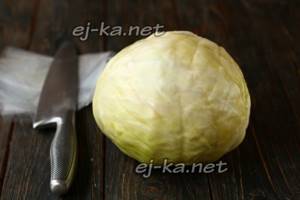
Cabbage varieties recommended by summer residents
Lebedeva-3-3
all posts by the author ADVICE: I sown cabbage for seedlings in the snow, covered it with plastic film. The snow melted. I opened it during the day and covered it at night. There were normal seedlings. But planting seeds in a permanent place is excellent. The tap root will be well developed and the cabbage will need less watering - I always plant SIBERIAN cabbage for storage, I really like RINDA, BELARUSSKAYA and SLAVA never fail, JUNE SOOT IS IN ORDER. (Slava is all cracked , we need a new variety, name with numbers - L)
— I have Landegijker as the main cabbage for storage, but Dutch and domestic seeds are heaven and earth, I need to get Dutch ones.
— “Kolobok” is good for storage. We eat it before the new June harvest. Heads of cabbage are hard-hard
— And instead of early JUNE cabbage, I plant SOLO heads of cabbage that are a little smaller, but they never crack
— “Belorusskaya” cabbage. As soon as I started planting it, I forgot about the softness when salting. Moskovskaya constantly let me down in this regard, and it is not suitable for storage.
— I plant only Dutch cabbage Krautman, Megaton for pickling. Parel is early. They all have a small stalk. Lennox storage.
— Several varieties of cabbage: Sibiryachka, Sugarloaf, (it also stores well) Nadezhda.
— And Kolobok is good, it doesn’t crack and stores well
— I don’t like varieties with bitterness, so I gave up the “Podarok” variety, I grow Slava and Moscow late, they are juicy and without bitterness, both varieties are suitable for pickling, but Slava has a drawback - it is prone to cracking, so until late It’s not worthy of autumn, but it’s good in fresh salads. Varieties that are intended for long-term storage should be used several months after harvest, during storage they accumulate sugar and become tastier (Kolobok, Amager, etc.).
— And I liked the cabbage “Cook”
— White cabbage should be planted in 3 varieties. Different in terms of ripening. Early, like June, but not a lot of it. Pickling, like Belarusian and for storage, like amager, koloboka, but I liked Valentina. It’s not tasty in the fall, but in late winter and spring as soon as from the garden. I also tried savoy cabbage for the first time this year and really liked it.
-Cabbage - Megaton, and Rinda, and Krumont
— Savoy is the best for cabbage rolls. Be sure to plant some. And for salads it’s excellent, tender. White cabbage: definitely Slava 231, Excellent gift. Some early one is a must (at least Transfer). Krautman is excellent in all respects, but where is the guarantee that they will sell it.
— I plant Belorusskaya, Kolobok, Nadezhda-late, Transfer, June-early, Movir, Snow globe
-Cabbage: SB3, Mother-in-law, Ulyana, Gift, Nadezhda, Rinza, Rinda.
— BEIJING likes the Nika variety
— This year I planted Kolobok, I really liked it (Nizhny Novgorod region). I planted all the cabbage like this: take out the soil on the back of a shovel, fill the hole 1/2 full with fresh grass, top with compost, ash, soil and unslaked lime, half a teaspoon per hole, mix everything and plant cabbage seedlings. I fertilized it once in early August with an infusion of herbs and hilled it up, the heads of cabbage are larger and tighter than ever, now I will always plant it this way. I read somewhere how a woman shared “I remember my mother’s words - wrap the tip of the root of the cabbage” - When planting seedlings, everyone Pinch the central root of the plants to make them grow better! You can feel it with your fingers, it’s thicker than others.
— This is the second year I’ve been planting Bronco cabbage. The pumpkin doesn’t look very big, but it’s so dense! In the spring, the already cleaned one weighed 4.5 kg. Well kept, juicy and tasty.
— Late cabbage SeDeK — Valentina, and SEMKO — Lennox were pleased already in the garden
— My neighbor has been planting CORONET cabbage for 2 years, the cabbage is awesome!
— Kharkov winter cabbage, Kolobok, Snow White, Turquoise, Yaroslavna, but last year I tried Aggressor - I liked it much more. I plant the seeds right in the garden in a hole, weed them in the summer and harvest them in the fall.
— I really liked the Kiloton cabbage, Megaton - large, juicy, tasty, good in pickling, stores well, still as good as new
— Cabbage uncooked-Valentina, Langedeyker, Kilaton, Doubler, for pickling Gloria.
— We plant cabbage varieties Megaton, Atria, Lyon and Rinda.
— I would also like to recommend SKYWALKER cauliflower. Large snow-white heads, very good quality. 95 days from planting seedlings.
Special cabbage for cabbage rolls
Tenderness itself! The same can be said about Savoy cabbage.
Have you ever tried savoy cabbage rolls? Their taste cannot be compared with anything! Cabbage leaves, as if made from expensive crinkled fabric, gently envelop the filling and simply melt on the tongue. How good is this delicious cabbage in salads! Did you know that the most delicious cabbage pie is made from Savoy cabbage?
So why do we limit ourselves to growing white cabbage? Yes, out of habit we give preference to the Russian garden lady. Although, despite the looseness of the head due to the delicate bubbly, slightly corrugated leaves, Savoy cabbage is stored well and for a long time, but you should not ferment it - it does not have that famous crispness like white cabbage.
Did you know that Savoy cabbage is the most cold-resistant and frost-resistant of all types of cabbage? Like all representatives of this genus, she loves water very much, but patiently endures its lack.
Of course, this cabbage produces the highest yields in floodplain areas. But where can the average summer resident get them? Therefore, set aside beds with fertile soil for it, take care of fertilizing with organic matter and potassium fertilizers.
This type of cabbage is grown through seedlings - for autumn-winter consumption it is sown on April 10-15. It is important not to pamper the seedlings in a warm greenhouse, but to stop watering a week before planting in a permanent place. But when planting, give the tender sprouts plenty of water.
Caring for Savoy cabbage is not difficult.
First of all, you need to add organic matter in the fall, and complex mineral fertilizer in the spring. Be sure to loosen the soil, carry out hilling at least three times, and destroy weeds and pests during the process.
Aphids, cabbage butterflies and slugs cause great harm to cabbage. It is better to use folk remedies to combat them. Until the heads of cabbage begin to set, I, for example, periodically dust the plants with dry ash and spray them with a decoction of wormwood, be sure to plant celery nearby, and then tighten the plantings with mesh white material such as tulle.
Don't rush to harvest the savoy cabbage. The longer it grows in the garden, the better its taste, and it can withstand frosts down to -8 degrees very well. In warm winters it thrives even under the snow. Try leaving 2-3 heads of cabbage, covering them high with snow - by the New Year all that remains is to dig up fresh heads of cabbage and prepare delicious cabbage rolls from the tender leaves. Just don’t forget to immerse the frozen head of cabbage in cold water for a few minutes before using it.
By the way, in order for Savoy cabbage to be stored for a long time and well, you do not need to remove all the green outer leaves - leave one layer. In the air in a cool room, these leaves will dry out, look and feel like parchment paper, and in this form the heads of cabbage will be stored in the basement without problems almost until spring.
For those who will grow and use Savoy cabbage for the first time, I want to give some advice. Give preference to mid-late varieties and hybrids. They produce dense heads of cabbage, store well, look very beautiful not only in the garden bed, but also in flower beds, thanks to the highly bubbly, corrugated leaves with a bluish coating. And the early varieties are good, but they are not for storage, and their heads grow smaller.
There are also secrets in the methods of preparing Savoy cabbage. Firstly, it is not fried raw, but only after blanching for 3-4 minutes. Secondly, before use, be sure to fill it with cold water for 5-10 minutes. And one more thing: Savoy cabbage should not be boiled in an aluminum container, and to eliminate the strong cabbage smell, cover the heads of cabbage an hour or two before use with a cotton napkin soaked in vinegar.
It is difficult to imagine a Russian garden without white cabbage, but there is no point in denying yourself the cultivation of other types. Moreover, nutritionists consider savoy cabbage to be the most suitable for children and the elderly, primarily because it is rich in easily digestible proteins, mineral salts, biologically active substances and vitamins.
How to cook cabbage for cabbage rolls in the microwave according to a step-by-step recipe with photos
for 12 people
10 minutes
27 kcal
5/5 (1)
I often hear from friends: “I really want homemade cabbage rolls, but I don’t have time to bother with them!” And I began to notice that when cooking dinner I choose something simpler and faster. After all, by the time you cook this cabbage to the desired state, an hour will pass, after which you no longer want anything.
Nowadays, this process has been made easier for us by our miracle helpers , which are now in the kitchen of any housewife. Of course, I'm talking about microwave ovens. Let's take a closer look at a simple idea and find out how to prepare cabbage for cabbage rolls in the microwave.
Cabbage leaves for cabbage rolls in the microwave
Kitchen appliances: microwave oven.
- To soften cabbage in the microwave for cabbage rolls, it is better to use a medium-sized cabbage. Before boiling cabbage for cabbage rolls in the microwave, you need to remove the spoiled leaves and cut out the darkened areas with a knife.
- Using a sharp knife, cut out the middle of the head. Microwave the cabbage, cut side down, for 10 minutes. If possible, you need to set the temperature to 100 degrees.
- After this time, remove the vegetable from the microwave and remove the leaves. They will come off easily. The cabbage will become very hot after cooking, so you need to be careful.
- You can keep the finished cabbage in cold water, allowing it to cool a little.
- Remove thick sections from the finished leaves, stack them on top of each other and put them in the microwave again for 10 minutes at a temperature of 100 degrees. The sheets are ready to use. These leaves can be stored in the freezer and used as needed.
Dear readers, I invite you to watch a short video that shows the entire process of preparing cabbage leaves for cabbage rolls using a microwave oven. You'll see how easy it is to separate cabbage into cabbage rolls that you've cooked in the microwave.
https://www..com/watch?v=fEWTiwYtis0&feature=youtu.be
Many housewives refuse to cook cabbage rolls because it is a very long process. Preparing cabbage leaves takes a lot of time and is often avoided by cooks.
Using technology, you can speed up the preparation of our favorite cabbage rolls. I recommend that you try preparing the leaves using the microwave.
It's very convenient and fast, so let me tell you how to do it yourself.
Here is another simple idea on how to cook cabbage in the microwave for cabbage rolls.
Preparing cabbage leaves for cabbage rolls
Cooking time: 10 minutes. Number of servings: 12 servings. Calorie content: 27 kcal per 100 g of product. Kitchen appliances: microwave oven.
It is much easier to remove the leaves from fresh cabbage, and they taste much more tender and tastier. Before you disassemble the cabbage into cabbage rolls, you can let it stand for a while to cool, or do it with gloves.
Step by step recipe
- Rinse a medium head of cabbage under running water. Microwave for 5 minutes at medium temperature.
- Then turn the cabbage over to the other side and cook in the microwave for another 5 minutes. If you wish, you can turn it over again and repeat the process.
- How many minutes it takes to cook cabbage for cabbage rolls in the microwave will directly depend on your oven. Perhaps, with its low power, it may take 10 minutes per side. Now you can easily remove the leaves and use them to form cabbage rolls.
recipe
Dear readers, I bring to your attention a short video that shows in detail the entire process of preparing cabbage for cabbage rolls in the microwave.
https://www..com/watch?v=6K9Q4x3iKPg&feature=youtu.be
Cooking options
- Since we have learned how to make preparations for cabbage rolls quickly and easily, it’s time to prepare a delicious dish. By the way, you can cook more cabbage rolls and store semi-finished products in the refrigerator. And when your family wants such a meal, you just need to defrost them and use this recipe, which details how to cook frozen cabbage rolls. Take this idea into your piggy bank and enjoy a delicious and healthy dinner.
- And here is a very easy step-by-step recipe with photos of cabbage rolls, which turn out very tender. I learned this recipe from a friend who is a huge fan of this dish and cooks it in various variations. Try my recipe and you will love the finished dish.
- If possible, cook cabbage rolls in a slow cooker. Thanks to this miracle technique, you will receive a tender and juicy dish, the products of which have retained almost all of their beneficial properties. It is also very convenient to cook in a slow cooker and use the “Reheat” function. Then you will have a hot lunch or dinner waiting for you at any time.
- The recipe for lazy cabbage rolls cooked in a pan on the stove does not lose its popularity. This is a very tasty and nutritious independent meal that is prepared very quickly. This dish will be another reason to eat cabbage, which contains many useful substances.
Source: https://www.alizy.club/myaso-i-ptitsa/s-ovoschmi/kapusta-dlya-golubtsov-v-mikrovolnovke.html
Cabbage for cabbage rolls: how to choose the right one
Not all chefs know how to cook cabbage rolls. One chef may turn out this dish more delicious than another, even though both of them created their culinary masterpiece using the same recipe. And all because one of them knew some cooking secrets that were inaccessible to the other.
The taste of finished cabbage rolls is largely influenced by the cabbage that was chosen for their preparation. It is the choice of the main ingredient – cabbage – that this article will focus on.
What are cabbage rolls
But, before we start talking about the rules for choosing cabbage, we should say a few words about what cabbage rolls in general are.
This dish is widespread throughout Eurasia. It is prepared and eaten both in Europe and in the Middle Eastern countries.
Moreover, in every country (moreover, even often in every home), cabbage rolls are prepared in their own way. Each chef has his own secrets for preparing this wonderful dish. Moreover, many keep their own recipes in the strictest confidence.
But regardless of the number of existing recipes and cooking secrets, traditional cabbage rolls remain unchanged. Their filling is minced meat mixed with rice. And the shell of cabbage rolls is cabbage leaves. Cabbage should be considered the main ingredient of this dish. After all, the filling is often replaced with another.
This is especially true for those who, for religious or other reasons, have refused to eat meat. Instead of minced meat, they will add vegetable ingredients to their cabbage rolls, for example, potatoes, beans, beans, and mushrooms. But the cabbage leaf will remain an essential component of cabbage rolls.
Cabbage selection
That is why great attention should be paid to the choice of cabbage when preparing this dish. The taste qualities of the finished cabbage rolls largely depend on it.
Experienced chefs advise choosing white, Chinese and Savoy cabbage first. White cabbage of any variety is suitable for cabbage rolls. The cook can give preference to those varieties that he likes best.
But basically this dish is prepared from young cabbage leaves, from winter and medium varieties. In general, July and August white cabbage is used in most cases.
Anniversary
The “Yubileinaya” variety cabbage belongs to the mid-late variety. This plant is usually harvested in August or September. Its growing season is about 5 months.
The main distinguishing feature of this type of cabbage is the high density of heads of cabbage. Their shape is as close as possible to spherical, and their weight is about 3 kg.
The leaves of this cabbage are suitable for consumption both fresh and heat-treated. Therefore, using “Jubilee” cabbage is an excellent solution.
Odyssey F1
Quite often, cabbage of the Odyssey F1 variety is used to prepare cabbage rolls. He belongs to the mid-season. Its ripening period is only 2.5 months. The weight of one head of cabbage is about 2 kg.
The most important advantage of this variety is its ease of care. The plant resists various diseases well.
The leaves of this variety, although very thin, contain a lot of juice. This is why the taste of the dish becomes more pleasant.
What should the leaves look like?
However, it is not so easy to determine the type of cabbage. When choosing heads of cabbage in a store, you should pay attention to the appearance of the product, as well as its softness and juiciness.
Softness
Cabbage leaves, which are used to prepare cabbage rolls, must first of all be soft enough. The softer the leaf, the easier it is to wrap the filling in it. In addition, soft leaves are easier to secure around the edges.
Of course, it is best to check the softness of the sheets in advance and choose the most suitable ones. However, the choice may not always be so large that very soft sheets can be found. And if neither in the garden nor in the store there are cabbage leaves suitable for softness, then you can take hard ones. But only before wrapping the filling will you have to soften them.
There are many methods for softening cabbage leaves. Here, too, each cook uses his own tricks. And one of the simplest ways is cooking. This, as well as other ways to soften leaves, will be discussed below.
Juiciness
An important characteristic of the cabbage leaf is also its juiciness. The juicier it is, the tastier the cabbage rolls will be. It is important that not only the filling is tasty, but also its wrapper. Otherwise, it will turn out that the cabbage leaf in this dish will be completely unnecessary.
Fragility
The cabbage leaf that you plan to use for cabbage rolls should be thin enough. But it is important that it does not break when bent.
The fragility of leaves can be easily determined by their color. White color indicates high fragility. When using white sheets, the cook will have to spend a lot of time wrapping the filling. In addition, in cooked cabbage rolls, the shell of such cabbage will be fibrous and tough.
Therefore, preference should be given not to white leaves, but to those that have a greenish tint. They bend easily and do not break. This means that the cook can give his cabbage rolls any shape.
How to cook cabbage in the microwave
Take a 2 kg head of cabbage. For cabbage rolls, try to use a slightly flattened head rather than a round one. This head of cabbage is shaped a little like a large tablet. This cabbage has large and thin leaves. Round cabbage is more suitable for pickling or other dishes that require chopping the vegetable.
Yes, and be sure to pay attention to the appearance of the leaves. If there are black spots on them, it means that this product has already been eaten before you. I mean small pests. Who were you thinking about?
Next there are 2 options.
Soften the cabbage in layers
After you decide on the head of cabbage, make 4 deep cuts at the stalk. Then put the cabbage in the microwave for 7-10 minutes. Set the microwave power to maximum. Next, pull out the head of cabbage and carefully remove the top leaves. Don’t drag it by force—tear off just enough to move away.
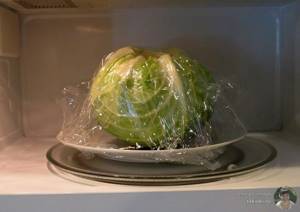
Then again you need to make a few cuts and put the head of cabbage in the microwave. This time for 5 minutes (also at maximum power). We take out the head again and remove a few of the top leaves. We make cuts and again send the head of cabbage to the microscope for 5 minutes. And continue to do this until the cabbage becomes very small.
Then we collect all the cabbage leaves that we separated from the head of cabbage and place them in the microwave. Keep them here for 3-5 minutes at high power. We do this to soften the leaves - they will sweat and become soft and translucent. Well, that's it, the cabbage is prepared - it's time to make cabbage rolls out of them.
Cabbage for cabbage rolls in a bag in the microwave
Compound:
- head of cabbage – 1–1.5 kg.
Cooking method:
- Wash the cabbage and remove the wilted leaves. Make deep cuts around the stalk.
- Place the head of cabbage in a bag or in a baking sleeve (the latter option is preferable). Use a toothpick to make several holes to allow steam to escape.
- Place the bag of cabbage in the microwave and turn it on for 3 minutes at maximum power.
- Remove, cool under running water and remove the top leaves. Repeat the procedure several times until the required number of leaves is collected.
Using the same technology, it is advisable to prepare Chinese cabbage for cabbage rolls. This will take less time: 2 minutes. In addition, a single treatment should be enough to soften it.
Cooking cabbage for cabbage rolls in the microwave is quick and safe. Knowing this method, you will pamper your loved ones with cabbage rolls much more often.
Cooking cabbage in the microwave
Compound:
- white cabbage – 1.5–2 kg.
Selection of heads of cabbage
By the appearance of the heads of cabbage, you can determine whether they are suitable for making cabbage rolls. It is recommended to give preference to even heads of cabbage. It is desirable that they be slightly flattened and not cone-shaped. They have at least three advantages. Firstly, they are easier to work with. Secondly, they are more tasty. And thirdly, their leaves are usually quite thin.
How to Soften Leaves
If the cabbage leaves that were chosen for preparing cabbage rolls are not soft enough, then they should be pre-processed in order to reduce the hardness. There are many ways to soften leaves. Here are some of them.
Cooking
The head of cabbage must be boiled, after removing the stalk. It is recommended to add a little vinegar to the water before cooking. The acid will help preserve the natural structure of the leaves and prevent possible tears.
Cooking should continue for several minutes. But you need to navigate not by time, but by the top leaves of the head of cabbage. As soon as they become transparent and begin to separate easily, cooking can be completed.
The cooked head of cabbage must be removed from the water and the leaves separated from it. If it turns out that the inside has not yet been cooked enough, it and the remaining leaves should be put back into boiling water.
And those leaves that have already cooked and become soft need to be cooled. If they have thick parts of the petioles, you should use a culinary hammer to beat them.
Baking
Another way to soften cabbage leaves is baking. All you need to do is place the head of cabbage in a heated oven and wait a little. The sheet can also be cooked in the microwave.
Freezing
You can also make the leaves softer by exposing them to low rather than high temperatures. First, the stalk is also removed. The head of cabbage is then packaged in a plastic bag and placed in the freezer.
After two days, when it is completely frozen, you just need to transfer it from the freezer to the bottom compartment of the refrigerator. And only then, when it is defrosted, you can disassemble it into leaves.
How to choose the right cabbage?
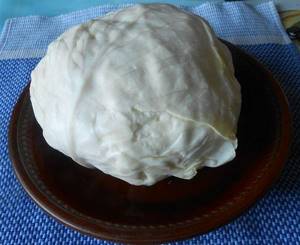
If you choose cabbage for cabbage rolls and cook it in boiling water, you need to know a few subtleties. The shape, size, color of the leaves, as well as the structure of the vegetable matter. You can cook any cabbage in the microwave so that it is convenient to wrap minced meat in it. However, if you follow the advice of experienced housewives, preparing cabbage will be even easier:
- the head of cabbage should not have a round, but an elongated shape - the leaves come off much easier from such cabbage;
- the cabbage should have large leaves - if they are small, it will be difficult to wrap the minced meat in them, and the cooking process will take a long time;
- leaves should be light (white with a greenish tint), without black spots, tears or damage, signs of fungus or mold;
- individual leaves must be dense, thick and elastic, otherwise they will quickly tear and the filling will no longer be able to be wrapped in them;
- wilting cabbage is not good - you can stew it with meat, and buy another head of cabbage for cabbage rolls.
You can soften cabbage leaves not only in boiling water or in the microwave. Cold has a similar effect.
First you need to freeze a whole head of cabbage, and then remove it from the freezer and defrost it at room temperature. However, after processing, cabbage can only be used for making cabbage rolls and cannot be stored even frozen.
Preparing cabbage for cabbage rolls in the microwave to soften is the easiest way. Even a novice housewife can cope with preparing a dish according to this recipe. The leaves are soft and elastic, hold their shape well and do not allow the cabbage rolls to fall apart.
Rating of the best cabbage varieties for pickling and storage
For many who have not experienced growing white cabbage, it seems that there are few varieties and they are all similar to each other. In fact, only if you take into account the best varieties of cabbage, there are more than 50 of them, and to this it is worth adding the best varieties of cabbage for pickling and storage, early-, mid- and late-ripening, etc. In total, today more than 80 varieties of white cabbage are officially registered; in addition, there are also cauliflower, red cabbage, Savoy, kohlrabi, Brussels sprouts and broccoli. But in this article we will talk specifically about the best varieties of white cabbage.
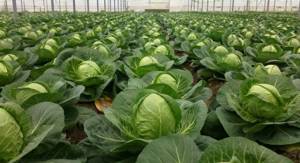
LiveInternetLiveInternet
When you choose cabbage for cabbage rolls, it is better to take small heads of cabbage, 700-800 grams each, their leaves are smaller and are just suitable for wrapping minced meat. If you have a large head of cabbage, you can cut each leaf into two parts: you need to cut along the dense “vein” of the leaf, cutting it out.
For me, the most expensive part of cooking cabbage rolls in the oven is softening the leaves. Previously, I always did this in boiling water in a large saucepan, which seemed quite inconvenient to me: you need to find a large enough saucepan, when you separate the leaves from the cabbage, water drips off, which burns your fingers, a puddle forms on the work surface, etc.
As you probably understand, with all my love for cabbage rolls, I made them quite rarely. But recently I tried a great way to soften cabbage leaves - in the microwave. This method is much more convenient and I highly recommend it to everyone.
In the text of the recipe, just in case, there are two options: both with and without a microwave.
Ingredients:
White cabbage - 1.5 kg (two small heads are better than one large one) Rice - 1 tbsp. (200 ml) Onions - 2 pcs. (medium size) Vegetable oil - 2 tbsp. Salt - to taste Black pepper - to taste Dill - 2 tsp. (dried, you can also use fresh) Minced meat - 500 g (beef and pork) Carrots - 2 pcs. (medium size) Oregano - 1 tsp. (dried) Tomatoes in their own juice - 500 g Garlic - 2 teeth. Sour cream - to taste (for serving)
Preparation:
1.
First of all, let's separate the leaves from the head of cabbage. If you remove them just like that, they will tear and break, so the head of cabbage needs to be softened a little first. To make the leaves separate better, we make cuts around the stalk with a wide knife (as if cutting it out).
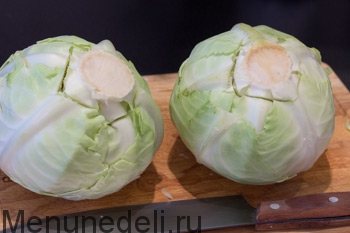
2.
First option: put the entire head of cabbage in the microwave, stalk side up, and turn it on at full power for 6-8 minutes (6 for a head of cabbage weighing 700 grams).
All microwaves have different power levels, so if you are using this method for the first time, check the cabbage after 6 minutes of heating. If the leaves have become soft and easily come away from the stalk without breaking, the cabbage can be removed. In the microwave, cabbage is “cooked” by heating the liquid contained inside it.
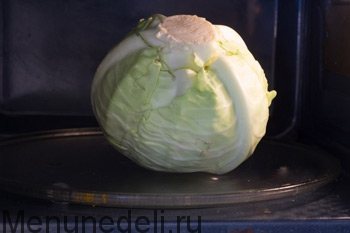
3.
If you overcook cabbage in the microwave, the edges of the leaves will begin to dry out a little. Separate all large leaves from the head of cabbage; the inner ones can be left for soup or stewing.
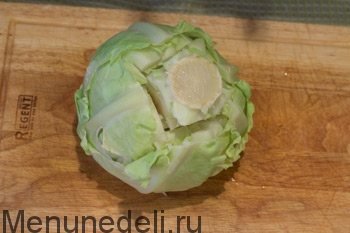
4.
These are the little heads of cabbage that remain; these leaves are no longer convenient for wrapping the filling in cabbage rolls. Place the leaves in a stack on a plate and place them in the microwave again for 3-4 minutes. After this, the leaves are ready for wrapping the filling.
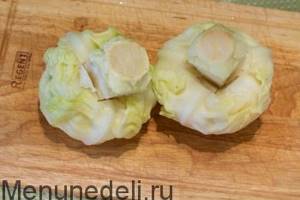
5.
Second option: Bring water to a boil in a large saucepan and cook the cabbage for about 6-8 minutes. If part of the cabbage does not fit into the water, turn the cabbage over after 3 minutes of cooking.
Carefully remove the cabbage from the pan (it is convenient to do this with a slotted spoon) and transfer to a cutting board. You can place a folded kitchen towel under the board to catch any water dripping from the cabbage. When the head of cabbage has cooled a little, separate the leaves, trimming a little at the stalk if necessary.
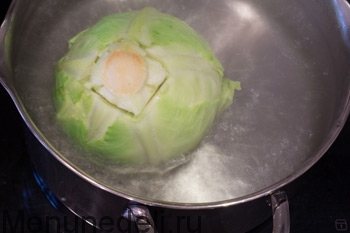
6.
Place individual leaves in the same pan with water for another 5 minutes. Now the cabbage leaves are ready for wrapping the filling in cabbage rolls.
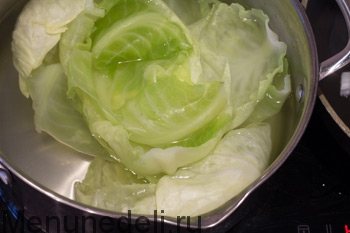
7.
While the cabbage is cooking, you need to let the rice cook. For a glass of rice you will need a little less than two glasses of water (to be precise, I pour 1 and 3/4 glasses), so the rice will turn out slightly undercooked and will be completely cooked when baking the cabbage rolls. Pour water over the rice, add a little salt and place on high heat. As soon as the rice boils, reduce the heat to low and cook until the water is absorbed.
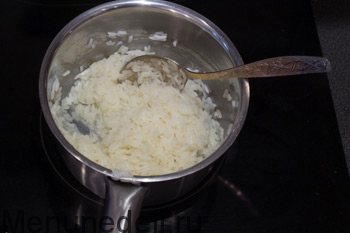
8.
Next, you need to fry the onions to fill the cabbage rolls. Finely chop both onions, we will need one for the filling, one for the sauce. Heat a tablespoon of oil and fry one onion over medium heat until translucent. Lightly salt and pepper the onion and add dried dill. Place the fried onion in a large bowl with the rest of the filling ingredients.

9.
Place minced meat, boiled rice and fried onions in a bowl.
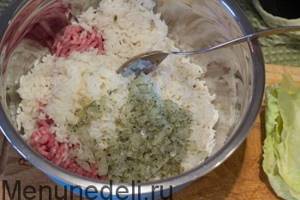
10.
Mix well until completely homogeneous.
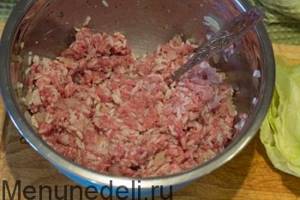
11.
Then we set the sauce to prepare. Fry the remaining onions in vegetable oil over medium heat. Add chopped garlic to the onion.

12.
Then add grated carrots and oregano.

13.
Tomatoes in their own juice need to be crushed a little with a fork right in the jar (or chopped with an immersion blender) so that the sauce is more homogeneous, and added to the frying pan. Stir and cook the sauce under the lid for about 10 minutes, just while wrapping the filling.

14.
Now you can turn on the oven to warm up to 180 degrees C and start wrapping the cabbage rolls. The widest and toughest part of the leaf vein can be slightly beaten with a meat mallet or the protruding part of the vein can be cut off.
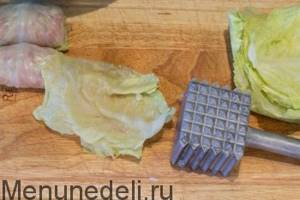
15.
Place some filling on the sheet.
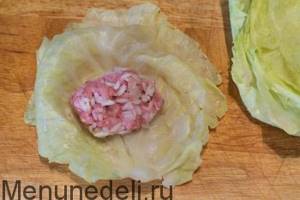
16.
We wrap the sheet with an “envelope”.
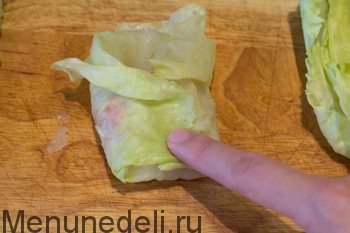
17.
We tuck the top edge under the side parts. If this cannot be done, it doesn’t matter, we will place the cabbage rolls with the seam down and they will not unfold.
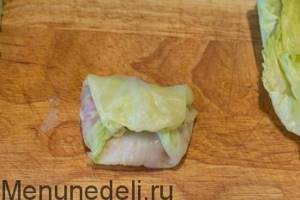
18.
Place the cabbage rolls tightly into the mold. For this oven-baked cabbage rolls recipe, it is best to use a thick-walled pan with a lid. If you're making double the amount of cabbage rolls, a high-rimmed baking sheet (can be covered with foil) works very well. You can place cabbage rolls in several layers in a deep form.
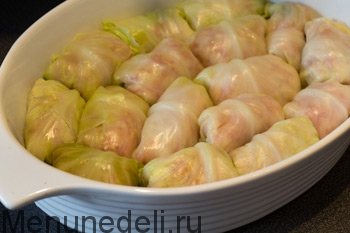
19.
Pour about a centimeter of water into the bottom of the mold. Top the cabbage rolls with tomato sauce. If your pan has a lid, cover with a lid; if not, cover tightly with foil. Bake the cabbage rolls in a preheated oven for 40-50 minutes.
Serve with sour cream.

Rating of the best varieties of early ripening cabbage
These forms are ideal for spring vegetable salads - light, soft, slightly crispy leaves, very juicy and tasty. Unlike mid-season ones, they ripen faster, are not as demanding on soil quality and take up less space. In greenhouses or greenhouses you can plant up to 10 heads of cabbage per 1 sq.m. and they will all fully develop and grow.
Among the most popular are the following varieties:
Rinda F1
A hybrid variety that reaches removable maturity already 76 days after germination. Stored until mid-summer maximum. The head of cabbage is quite dense, but not tight, and can even be used for main courses. Can grow in any soil provided the temperature is stable (in greenhouses) and the soil is not too dense. It is recommended to periodically loosen the root zone, providing air access.
Cossack F1
A hybrid variety of super fast ripening - removable maturity occurs already 40 days after planting the seedlings, and 76 days after planting the seeds. The heads of cabbage are elastic, light green in color, the taste is sweetish, without early bitterness. It is grown only in greenhouses and greenhouses, and is little susceptible to diseases. The average weight of one head of cabbage reaches 1.5 kg. Stored for 4 months.
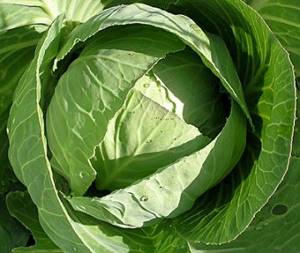
June
This is also the most common cabbage; the seeds are the best varieties for open ground. Heads of cabbage can be cut 60 days after planting the seedlings in a greenhouse or greenhouse and 76 days after planting the seeds. The color is light green, the taste is without bitterness, the structure is dense, not loose. Stores well for 3-4 months. You can leave it on the root for up to 2 weeks after ripening, and still it will not crack or fall apart into sheets. It also grows well in open ground and tolerates frosts well, but not long-term frosts. Suitable for central Russia, in the Urals and Siberia, to obtain an early harvest, it is grown only in greenhouse shelters.
Tobia F1
Large-fruited variety, where each head of cabbage weighs about 5.5-6 kg. The top leaf is bright green, gradually turning yellowish at the stalk itself. Juicy, very sweet, ideal for spring salads and first courses. Pickling doesn't have the best taste. And it is not stored fresh for long – within a month. If left on the root, it will not crack for a long time.
The best varieties of cabbage for pickling for the winter
Here we will also tell you which varieties of cabbage are best for pickling. Canning and salting early forms is not recommended. Despite its fairly dense structure and rich taste, when salted cabbage becomes like sauerkraut and absolutely tasteless. Therefore, for winter preservation, it is recommended to use those varieties that reach technical maturity after at least 140 days. They are mainly planted in the soil of grass snakes in the form of seedlings (in greenhouses and greenhouses they can also be planted as seeds), after which the cover is removed and the plant is allowed to gain sunlight. Basically, such forms are resistant to diseases, but some varieties are susceptible to diseases. Among the main ones are bacteriosis, white and gray rot; fomoz occurs very rarely, usually in closed ground.
As a rule, the epidemic starts from tomatoes and spreads to cabbage. If possible, these vegetables should be grown separately from each other, or immediately, when the first signs of disease are detected, all crops should be treated.
Glory
One of the most popular varieties, producing a harvest already 3.5 months after planting the seedlings. Excellent for fresh consumption and for fermentation. The heads of cabbage are slightly flattened, weighing 4.5-5 kg. The top leaf is light green, the center is white, the stalk is small. It is stored without processing all winter, grown for export, that is, it tolerates transportation well.
Atria F1
If you need cabbage for pickling, the best varieties are led by the Atria hybrid. Gives a large harvest, reaching full maturity 140 days after full germination. The heads of cabbage are elastic, dense, ferment well, and the leaves are also good for cabbage rolls. The taste is juicy, sweetish, without bitterness. Does not crack even after prolonged exposure to measles. Stored all winter.
Present
Refers to the forms of medium maturation, removable maturity occurs on the 135th day after planting the seedlings. It is not afraid of frost, but slows down growth during prolonged cold spells. It is recommended to grow in greenhouse conditions; when a stable above-zero temperature is reached and the sunny day lasts more than 6 hours, the cover is removed. Average resistance to diseases - they are not breeding grounds, but may suffer during an epidemic. Stored throughout the winter.
Midor F1
Hybrid form, ripening on the 155th day after full germination. The top leaf is a rich green color with a waxy coating, which ensures excellent preservation throughout the winter. The heads of cabbage are very dense, multi-leafed, and the stalk is small. Pronounced taste, no bitterness, ideal for pickling.
The best cabbage varieties to store for the winter
It is best to use for this purpose those forms that ripen for more than 145 days, but even mid-ripening ones will last through the winter in a completely viable state and will not lose their taste and elasticity of the leaves. There is no fundamental difference in storage between these two forms. But it is traditionally believed that the later the cabbage is removed from the root, the longer it will remain with all the vitamins and beneficial microelements.
Aggressor F1
This is not just one of the most productive and shelf-stable varieties, it will easily top the ranking of the best cabbage varieties for central Russia. In addition to the fact that the Aggressor does not require special soil, careful care, large amounts of fertilizers and regular watering, it is practically not susceptible to diseases, and cut heads of cabbage can be stored for more than 6 months. The vegetable is quite large - up to 5 kg, does not crack, and remains elastic throughout the entire storage period. Great for salads, first and second courses and pickling.
Snow White
It ripens 3.5 months after planting the seedlings, grows well in open areas, but it is recommended to plant the seedlings in greenhouses or greenhouses. The heads of cabbage are dense, elastic, the leaves are snow-white and crispy. Due to the high concentration of nutrients, it is recommended for baby and dietary nutrition. It can be stored for more than 6 months without cracking or rotting. The variety itself is resistant to Phoma, but requires regular watering and fertilization. It is optimal for this purpose to use rotted compost or wood ash mixed with soil.

Valentina F1
A late-ripening form that reaches removable maturity 145-150 days after full germination. Unpretentious, watering infrequently, resistant to diseases and short frosts. It is better to plant seedlings in greenhouse conditions. The heads of cabbage are dense, but the leaves are removed very easily, due to which this variety is often grown for cabbage rolls. A hybrid variety that does not produce seeds for the next year.
Kolobok F1
A late-ripening hybrid that produces large, dense fruits weighing 5-5.5 kg. It may be affected by gray mold, or in exceptional cases by fomoz. Heads of cabbage sometimes rot, so the crop should be periodically checked for rot during storage. In general, Kolobok cabbage is a productive variety that can be stored for up to 7 months.
The best varieties of cauliflower
Compared to white cabbage, cauliflower is a relatively new guest on the Russian table, but it has long been loved by our fellow citizens. A whole complex of valuable amino acids, including lysine and arginine, ease of preparation, pleasant taste, low calorie content - there are a lot of useful properties. Today it is grown in many greenhouses, especially since it is unpretentious in care and is little susceptible to diseases.
Cabbage for cabbage rolls in the microwave for softening - 5 recipes with photos step by step
Take a head of cabbage prepared specifically for cabbage rolls and inspect it carefully. All dirty, spoiled, flabby and “suspicious” leaves must be removed. When the cabbage head is cleared of excess, you need to take a sharp knife and carefully make deep cuts around the stalk.
This is to make it easier to separate the leaves. You can remove the stalk from the head of cabbage in advance, but you can also leave it. Next you need to take a regular bag or a baking bag. Place the head of cabbage inside the bag, then tie it tightly or secure it - if you are using a baking bag.
Closing the bag is necessary to create a steam bath that will soften the leaves. Next, you need to place the cabbage in a bag in the microwave. The further process depends on the power of the microwave and the size of the cabbage. So the cooking time is selected individually: per head of cabbage 1-1.5 kg.
Usually 10-15 minutes at 700 W is enough. After the allotted time, remove the cabbage from the microwave and carefully untie the bag. The cabbage will be very hot and condensation will be too, so be careful not to burn yourself. The head of cabbage will cool to an acceptable temperature in about five minutes.
The leaves from the head of cabbage should come off easily and without effort. A large head of cabbage may not be completely steamed, then by the middle the leaves will be even harsher. In this case, you can repeat the procedure and warm up the head of cabbage for another three minutes. When all the leaves are removed, the cabbage is ready for further manipulation.
Young cabbage leaves can be easily softened in the microwave instead of boiling them in boiling water. It will be faster and easier this way.
Ingredients:
- White cabbage - 1.5-2 kg.
- Water - 1-1.5 tbsp.
Cooking process:
- Take young cabbage with thin elastic leaves and remove the top layer of leaves. Dirty, wrinkled and torn leaves go into the trash bin.
- Using a sharp knife, make deep cuts around the stalk - this will make it easier to remove the leaves. Carefully separate the leaves from the stalk and rinse them in cool running water.
- Divide all the leaves into equal portions that will fit well on a microwave-safe dish and set the microwave to high power. Place the first portion of leaves on a dish and place it in the oven.
- Set the microwave timer to 3 minutes and turn on the appliance. If the portion of leaves turned out as desired, continue to soften the leaves in portions, remembering to moisten them with water before putting them in the microwave.
- When all the leaves are ready, remove the tops of the tough veins with a sharp knife and begin preparing semi-finished cabbage rolls. Good culinary success to you!
Softening cabbage in the microwave
This is a very quick way to prepare leaves and, of course, cabbage rolls from them. You will significantly reduce cooking time if you use this method.
Ingredients:
Cooking process:
- Choose a good head of cabbage, not too large and preferably flattened. Remove the top layer of dirty and torn leaves that are not suitable for making cabbage rolls.
- Make cuts around the stalk using a sharp knife. You don’t have to remove the stalk, it doesn’t really matter. Place the processed head of cabbage in a deep microwave-safe bowl and place in the oven.
- Set the microwave to high power and set the timer for five minutes. During this time, the top layer of leaves will soften. Rinse the head of cabbage under cold water, remove the top leaves and repeat the softening procedure again.
- While the new leaves are being processed, you can just wrap the first batch of cabbage rolls. This way the process will be many times faster than the classic method of preparing cabbage leaves.
- Select the optimal time for steaming cabbage leaves experimentally, as it depends on the power of the microwave and on the cabbage head itself. Therefore, set the optimal time yourself on the first portion specifically for your device and gradually soften the head of cabbage until all the leaves are cooked.
Peking for cabbage rolls in the microwave
As you know, cabbage rolls can also be prepared from Chinese cabbage. However, pekinka leaves also need to be processed, and the microwave greatly simplifies this process.
Ingredients:
- Head of Chinese cabbage - 1 pc.
- Water
Cooking process:
- Buy a head of Chinese cabbage, fresh and having a beautiful light green color. Carefully separate the leaves - this is not at all difficult, unlike regular white cabbage.
- Rinse the cabbage leaves under running water and trim off all the white bottom of each leaf. Take a large microwave-safe dish and place a small portion of Chinese cabbage leaves in it.
- Place the cabbage dish in the microwave, set to the highest power setting and cook the cabbage leaves for five minutes. During this time, they will become soft and elastic enough to form cabbage rolls.
- Do the same with the rest of the Chinese cabbage leaves, warming them in small portions, then trim off the tops of the thick veins that are on the leaves.
- While the next portion of leaves is being prepared, you can wrap the filling in the previous portion. Very convenient and a great time saver!
Savoy cabbage: lace cabbage
Savoy cabbage is much sweeter than white cabbage, and in its nutritional qualities it is in many ways superior to its relative; this type of cabbage is especially useful for children and the elderly. It, like white cabbage, comes from wild species growing on the shores of the Mediterranean Sea. It got its name from the Italian county of Savoy, whose population has grown it since ancient times.
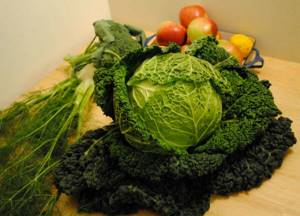
Today, this particular type of cabbage is widespread in Western Europe and the USA, occupying huge areas there. There it is eaten more than all other types of cabbage. But in Russia it is not widespread. There are several reasons for this - it is less productive, poorly stored and more demanding to care for.
It tastes similar to cauliflower. In cooking, Savoy cabbage is considered the best cabbage for making cabbage rolls and pies; it makes the most delicious cabbage soup and vegetarian soups; it is indispensable in summer salads. And any dish made from it is much tastier than the same one made from white cabbage. It is clear that Europeans and Americans were not mistaken when choosing the filling for their pies.
In addition to its taste, it has one more advantage: its leaves are very tender and do not have hard veins, like the leaves of its white cabbage relative. The corrugated leaves of savoy cabbage are directly intended for cabbage rolls, because... It is convenient to place the minced meat in the hollow of a damp sheet, and the sheet itself can easily be folded into an envelope or rolled into a tube. It is plastic without boiling and does not tear. But for the traditional Russian pickling of cabbage, it is not suitable at all, because... It does not have the crunchiness that is so necessary for this dish, like its white-headed sister.
It has valuable nutritional and dietary properties. In terms of vitamin C content, it competes with potatoes, oranges, lemons, tangerines, and contains other vitamins. These substances play an important role in normal human nutrition, improve digestion, metabolism, cardiovascular activity and actively influence other processes. The protein and fiber in savoy cabbage are very easy to digest. That is why this product is part of the most gentle therapeutic diets and is of high value for the prevention and treatment of numerous gastrointestinal diseases.
Biological features
In appearance, Savoy cabbage is similar to white cabbage. But its head of cabbage is much smaller in size, because it consists of thinner and more delicate leaves. Heads of cabbage have different shapes - from round to flat-round. Their weight ranges from 0.5 to 3 kg, they are much looser than that of white cabbage. The heads of cabbage have many covering leaves and are prone to cracking. It is also very important that they are less damaged by pests and diseases than heads of white cabbage.
The leaves of Savoy cabbage are large, very curly, wrinkled, bubbly, and have a green color with different shades depending on the variety. The natural conditions of central Russia are well suited for growing this healthy vegetable. It is more frost-resistant than other types of cabbage. Some late varieties of Savoy cabbage are particularly resistant to cold.
Its seeds begin to germinate already at a temperature of +3 degrees. In the cotyledon phase, young plants can withstand frosts down to -4 degrees, and established hardened seedlings tolerate frosts down to -6 degrees. Adult plants of late-ripening varieties easily tolerate autumn frosts down to -12 degrees.
Savoy cabbage can be left later in the garden under the snow. Before use, such cabbage must be dug up, cut, and doused with cold water. At the same time, low temperatures have a beneficial effect on the taste of heads of cabbage; it retains all its medicinal properties.
Savoy cabbage is more drought-resistant than other types of cabbage, although at the same time it is demanding of moisture, because... the evaporating surface of its leaves is very large. This is a long-day plant, light-loving. It has significant resistance to leaf-eating pests.
It is demanding of high soil fertility and responsive to the application of organic and mineral fertilizers, with mid-ripening and late-ripening varieties being more demanding than early-ripening varieties.
How to quickly soften cabbage for cabbage rolls in the microwave
To prepare cabbage rolls, it is better to choose large forks with a flattened shape - they have a larger leaf area compared to round heads of cabbage. You should not use too “old” cabbage, which remains at the end of winter from the last season - it has hard leaves with thick veins. Even if you manage to soften such a fork, it will be difficult to roll classic cabbage rolls beautifully and neatly. It is better to make lazy cabbage rolls or cabbage cutlets from such cabbage.
Wash the head of cabbage well under the tap, remove and discard 1-2 layers of the top leaves that are dirty or damaged. Using a sharp knife, cut out the stalk. To do this, make several deep cuts around the perimeter, tilting the knife towards the center of the fork, so that a wedge is formed at the end of the stalk, and it is easy to separate it from the main part of the cabbage.
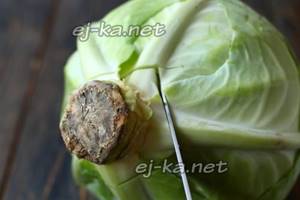
Carefully remove the stalk. There will be approximately this hole left in the fork. Next, there are 2 options, depending on the “age” of the cabbage. Young forks can be disassembled immediately; their thin green leaves will be easily separated without damage. Old cabbage needs to be softened whole.
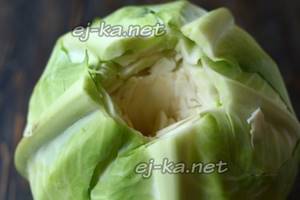
Place the head of cabbage in a heat-resistant bag and tie it. The film will create the effect of a steam bath, which will accelerate the softening of the leaves and prevent them from drying out under the influence of microwaves. Place the packed cabbage on a dish intended for cooking and heating dishes in the microwave. Place in the microwave, set the “microwave” mode, power – 800-1000 W, time – 8-10 minutes.
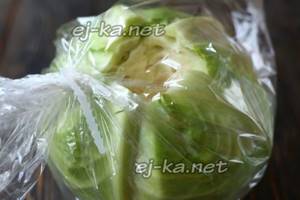
After the microwave oven signal, remove the cabbage, carefully untie the bag (be careful, there will be hot steam inside!) and remove the forks. Immediately place it under cold water.
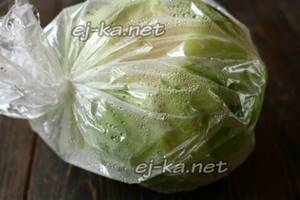
When the head of cabbage has cooled a little, disassemble it into separate sheets, starting to separate them from the top, taking hold of the thinner part and gradually moving towards the hole from the stalk.
Savoy cabbage varieties
Among the varieties of Savoy cabbage for growing in gardens, it is worth noting the following:
- Alaska F1 is a late-ripening hybrid. The leaves are strongly vesicular, with a thick waxy coating. The heads of cabbage are dense, weighing up to 2 kg, have excellent taste, and are suitable for long-term storage.
- Vienna early 1346 is an early ripening variety. The leaves are dark green, heavily corrugated, with a faint waxy coating. The heads of cabbage are dark green, round, of medium density, weighing up to 1 kg. The variety is very unstable to cracking.
- Vertus is a mid-late variety. The heads of cabbage are large, weighing up to 3 kg, with a piquant taste. For winter consumption.
- Vertu 1340 is a medium-late yielding variety. The leaves are gray-green, with a waxy coating. The heads of cabbage are flat-rounded, weighing up to 2.5 kg, of medium density, stored until mid-winter.
- Virosa F1 is a mid-late hybrid. The heads of cabbage have good taste and are intended for winter storage.
- Golden early is an early ripening variety. Heads of cabbage are of medium density, weighing up to 0.8 kg. An excellent variety for fresh use, resistant to cracking of heads of cabbage.
- Cosima F1 is a late-ripening, productive hybrid. The heads of cabbage are medium-sized, dense, weighing up to 1.7 kg, yellowish when cut. Stores well in winter.
- Comparsa F1 is a very early ripening hybrid. The heads of cabbage are light green, medium density, resistant to cracking.
- Kroma F1 is a mid-season hybrid. The heads of cabbage are dense, weighing up to 2 kg, green, with a small inner stalk, suitable for long-term storage. The taste is excellent.
- Melissa F1 is a mid-season hybrid. The heads of cabbage are highly corrugated, of medium density, weighing up to 2.5–3 kg, with excellent taste. Resistant to cracking of heads of cabbage, well stored in winter.
- Mira F1 is a very early ripening hybrid. Heads of cabbage weighing up to 1.5 kg, do not crack, and have excellent taste.
- Ovasa F1 is a mid-late hybrid. Its leaves have a strong waxy coating and a coarse blistered surface. The heads of cabbage are average. Plants are resistant to adverse weather conditions and are slightly affected by mucous and vascular bacteriosis and Fusarium wilt.
- Savoy King F1 is a mid-season hybrid with a large rosette of light green leaves. Plants form large and dense heads of cabbage.
- Stilon F1 is a late-ripening hybrid. The heads of cabbage are blue-greenish-gray, round, resistant to cracking and frost.
- Sphere F1 is a mid-season productive hybrid. Heads weighing up to 2.5 kg with dark green covering leaves, medium density, yellow when cut, good taste.
- Julius F1 is an early ripening hybrid. The leaves are finely blistered, the heads are round, of medium density, weighing up to 1.5 kg, transportable.
